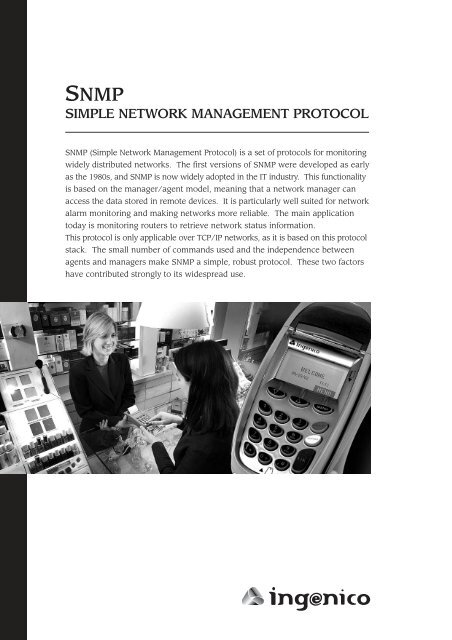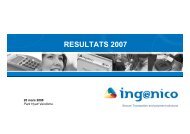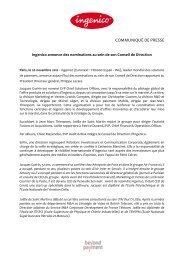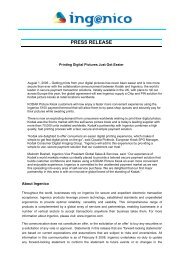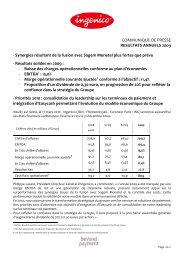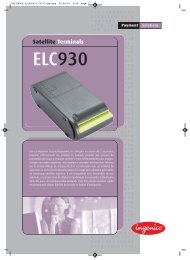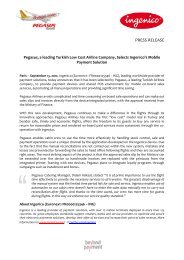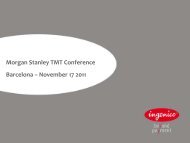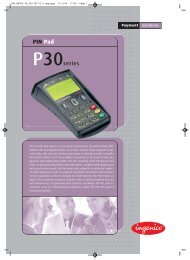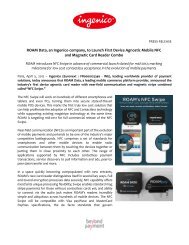SNMP - Ingenico
SNMP - Ingenico
SNMP - Ingenico
Create successful ePaper yourself
Turn your PDF publications into a flip-book with our unique Google optimized e-Paper software.
<strong>SNMP</strong><br />
SIMPLE NETWORK MANAGEMENT PROTOCOL<br />
<strong>SNMP</strong> (Simple Network Management Protocol) is a set of protocols for monitoring<br />
widely distributed networks. The first versions of <strong>SNMP</strong> were developed as early<br />
as the 1980s, and <strong>SNMP</strong> is now widely adopted in the IT industry. This functionality<br />
is based on the manager/agent model, meaning that a network manager can<br />
access the data stored in remote devices. It is particularly well suited for network<br />
alarm monitoring and making networks more reliable. The main application<br />
today is monitoring routers to retrieve network status information.<br />
This protocol is only applicable over TCP/IP networks, as it is based on this protocol<br />
stack. The small number of commands used and the independence between<br />
agents and managers make <strong>SNMP</strong> a simple, robust protocol. These two factors<br />
have contributed strongly to its widespread use.
HOW <strong>SNMP</strong> WORKS 3<br />
INGENICO’S <strong>SNMP</strong> IMPLEMENTATION 3<br />
EXAMPLE USES 5<br />
DYNAMIC STATISTICS 5<br />
PREVENTIVE DIAGNOSTICS 5<br />
DYNAMIC TERMINAL MANAGEMENT 5<br />
CONCLUSION 5
<strong>SNMP</strong><br />
HOW <strong>SNMP</strong> WORKS<br />
<strong>SNMP</strong> is based on the manager/agent model. This<br />
model allows <strong>SNMP</strong> managers to remotely access<br />
information stored by agents. The manager and<br />
agent use a Management Information Base (MIB)<br />
and a short set of commands to exchange<br />
information, making the <strong>SNMP</strong> protocol light and<br />
easy to implement.<br />
HUMAN<br />
NETWORK<br />
MANAGER<br />
MANAGEMENT<br />
SYSTEM<br />
MANAGER<br />
Database<br />
Figure 1. Basic <strong>SNMP</strong> model<br />
NETWORK<br />
PROTOCOL<br />
MESSAGES<br />
TARGET<br />
AGENT<br />
Managed<br />
Objects<br />
<strong>SNMP</strong> uses only five basic messages to manage<br />
communication between the manager and agent.<br />
The first two messages (Get, GetNext) allow the<br />
manager to request information for a specific object<br />
or list of objects. The agent then replies through<br />
a GetResponse message that contains either the<br />
requested information or an error code (the Third<br />
message).<br />
When the manager wants to obtain the value<br />
of an object, it creates a Get message that includes<br />
the Object Identifier (OID) for each object of interest,<br />
and sends this message to the agent. The agent<br />
then checks whether the OIDs are included in its<br />
base. If they are, it replies with the objects’ value;<br />
if they are not, it sends an error code.<br />
The fourth message (Set) allows the manager<br />
to request a change in the value of a specific<br />
variable. To reply, the agent uses the GetResponse<br />
message to either provide the information or give<br />
an error code.<br />
The final message (Trap) allows the agent to<br />
inform the manager of a significant event.<br />
Most of the messages are issued only by the<br />
<strong>SNMP</strong> manager. The Trap message is the only one<br />
initiated by the agent, and is typically used to notify<br />
the manager of an alarm condition – before the<br />
manager queries that object.<br />
When the agent detects that one of its objects<br />
listed for <strong>SNMP</strong> has been modified, it generates<br />
a Trap message to inform the manager. This allows<br />
the manager to deal with the new value more<br />
proactively, as opposed to waiting for the next time<br />
that particular object is queried.<br />
<strong>SNMP</strong>’S ADVANTAGES<br />
• It is LAN/WAN based. Because <strong>SNMP</strong> allows<br />
data transfer over existing LAN/WAN networks, it<br />
significantly cuts deployment and operating costs.<br />
• It is an open standard. <strong>SNMP</strong> is available<br />
free-of-charge, is documented extensively, and is<br />
supported by most telecoms equipment providers.<br />
• It is expandable. Although <strong>SNMP</strong> is light and simple,<br />
it can be expanded to support a wide variety of<br />
connected devices.<br />
• It is platform-independent. An <strong>SNMP</strong> manager can<br />
be configured through the Management Information<br />
Base (MIB) to enable data transfer with any device<br />
supporting <strong>SNMP</strong> (e.g., combined IT & POS<br />
environments).<br />
INGENICO’S <strong>SNMP</strong> IMPLEMENTATION<br />
<strong>SNMP</strong> has been implemented by <strong>Ingenico</strong> across<br />
its product lines, in order to support customers in<br />
remote POS administration. This implementation<br />
was carried out through an LNET library upgrade,<br />
the addition of an <strong>SNMP</strong> agent in the new<br />
L<strong>SNMP</strong> library, and an OS upgrade. <strong>Ingenico</strong>’s<br />
implementation is fully compliant with the standard<br />
and is based on version 2.c <strong>SNMP</strong>.<br />
INGENICO 2007<br />
3.
The <strong>SNMP</strong> module is launched automatically<br />
when a terminal is booted, and offers immediate<br />
functionality to the agent (the <strong>SNMP</strong> function<br />
can be deactivated if needed). This protocol can<br />
be used by any terminal with a TCP/IP stack:<br />
Ethernet, WiFi, Bluetooth, GPRS, CDMA, etc.<br />
<strong>SNMP</strong> can be used to retrieve statistical data<br />
about POS terminals that is stored on a central<br />
network manager. Three types of data can be<br />
obtained:<br />
• OS data;<br />
• TCP/IP stack information;<br />
• Application data.<br />
The OS data include:<br />
• Number of terminal boots;<br />
• Number of pixel lines printed;<br />
• Number of magnetic cards swiped<br />
(and with at least one good track read);<br />
• Number of smart cards inserted<br />
(asynchronous or synchronous);<br />
• Number of modem calls<br />
(and successful modem calls);<br />
• Number of keys pressed.<br />
This data can be activated on all <strong>Ingenico</strong><br />
terminals. The schematic below illustrates how<br />
OS data is retrieved using <strong>SNMP</strong>.<br />
OS<br />
Application<br />
L<strong>SNMP</strong><br />
agent<br />
�<br />
TCP/IP<br />
stack<br />
OS data<br />
INTERNET<br />
Figure 2. <strong>SNMP</strong> retrieval of OS data<br />
L<strong>SNMP</strong><br />
manager<br />
TCP/IP stack information provides details on<br />
the amount of data sent and received, the protocol<br />
used, the transfer success rate, etc. Applications<br />
can also generate specific counters for tracking<br />
targeted indicators.<br />
All this information is stored by the <strong>SNMP</strong> agent<br />
to be presented to the remote manager. However,<br />
an application can specify that its information<br />
be non-public, in which case the agent will not<br />
send it to the manager.<br />
The network manager collects data from<br />
the terminal through regular contact at defined time<br />
intervals, and can reset some counters to enable<br />
fully automated management. For example, the<br />
number of Visa or MasterCard cards used on the<br />
terminal can be counted over a set time period, then<br />
reset to zero at the start of the next time period.<br />
The schematic below illustrates the <strong>SNMP</strong><br />
agent response when OS, TCP/IP, and application<br />
objects are declared.<br />
Application<br />
statistics<br />
OS<br />
Application<br />
L<strong>SNMP</strong><br />
agent<br />
� �<br />
�<br />
TCP/IP<br />
stack<br />
TCP/IP<br />
stack<br />
information<br />
OS data<br />
INTERNET<br />
L<strong>SNMP</strong><br />
manager<br />
Figure 3. <strong>SNMP</strong> functionality with OS, TCP/IP, and application objects<br />
<strong>Ingenico</strong> has also implemented the Trap message<br />
discussed earlier, which is used by the terminal<br />
to notify the network manager that an object has<br />
been modified. The manager can thus check the<br />
object immediately to view the updated information.<br />
INGENICO 2007<br />
4.
The Trap message is useful for tracking statistics<br />
like paper status or reboot sequence, and allows<br />
real-time control of a group of terminals without<br />
the need for a field technician. Alerts of object<br />
modifications are sent automatically by the<br />
application to one or more network managers.<br />
Another benefit of the Trap message is that it<br />
can work the other way round. A network manager<br />
can set a new value in an application's object,<br />
which will then force the application to launch<br />
an OS update or data collection sequence.<br />
EXAMPLE USES<br />
<strong>SNMP</strong> is now a common technology and increasingly<br />
available on network servers. Thanks to <strong>SNMP</strong><br />
standards, <strong>Ingenico</strong> customers can manage their<br />
terminals easily through a single application<br />
on a server. <strong>Ingenico</strong> customers can access <strong>SNMP</strong><br />
terminals from any structure supporting TCP/IP,<br />
so that implementation can be a simple extension<br />
of an existing IT administration application<br />
or a bank or third-party server.<br />
Moreover, implementing <strong>SNMP</strong> facilitates the<br />
administration of a group of <strong>Ingenico</strong> terminals.<br />
More specifically, it can be used for the following:<br />
DYNAMIC STATISTICS<br />
• Network performance based on TCP/IP data<br />
• Transaction volume data<br />
• Payment statistics, so that banks can adapt their<br />
services to retailers’ needs<br />
(e.g., specific functions for low payments, a new<br />
telecom subscription offer, etc.)<br />
PREVENTIVE DIAGNOSTICS<br />
• Dynamic trouble-shooting<br />
• Field preventive maintenance<br />
(e.g., the early detection of an increase in modem<br />
call failure or magnetic strip reading)<br />
DYNAMIC TERMINAL MANAGEMENT<br />
• Modifications to data transfer connections<br />
between agents and servers<br />
• Automatic maintenance procedure generation<br />
(i.e., if a server detects a possible incompatibility<br />
with an application or updated communication<br />
parameters, it can automatically request that<br />
the agent launch an application upgrade through<br />
the <strong>SNMP</strong> manager)<br />
• Terminal queries for parameter and/or<br />
configuration upgrades<br />
CONCLUSION<br />
By implementing the <strong>SNMP</strong> technology, <strong>Ingenico</strong><br />
has again demonstrated its desire to provide<br />
customers with the best-suited and most<br />
cost-effective solutions available. This widespread,<br />
light protocol is easy to deploy, and allows <strong>Ingenico</strong><br />
terminals to be integrated into an existing <strong>SNMP</strong><br />
environment if needed.<br />
Groupe <strong>Ingenico</strong><br />
192, avenue Charles de Gaulle<br />
92200 Neuilly-sur-Seine - France<br />
Tel : +33 (0)1 46 25 82 00<br />
Fax : +33 (0)1 47 72 56 95<br />
www.ingenico.com 02-2007


